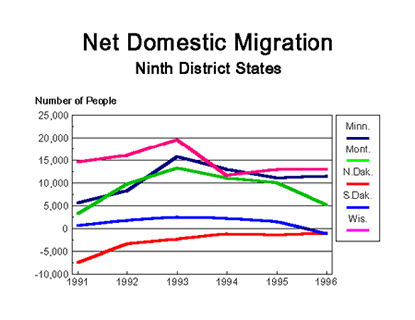At last fall's meeting of the Minneapolis Fed's Advisory Council on Small Business, Agriculture and Labor, one Montana member said, "No one's euphoric, no one's depressed." But she said some members of the business community are concerned that 1997 will be flat.
At the same meeting, a Wisconsin member was very bullish on economic prospects for the coming year, and members from Minnesota and the Upper Peninsula shared that optimism. As for the Dakotas, members expected moderate growth to continue, although some expressed concerns about particular sectors, such as tourism and cattle ranching.
Those views largely reflect the finding's of the Minneapolis Fed's recent business conditions poll and the expectations of the bank's forecasting models Similar responses were also reported in the bank's quarterly survey of the Ninth District's agricultural bankers. In brief, all these sources point toward continuing growth in 1997, although at a slower rate, with the district's western states expected to experience a more pronounced slowdown.
Moderation is the word
Nonfarm employment growth in the Ninth District moderated last year, with the same performance expected in 1997, according to the Minneapolis Fed's forecasting models. Growth in nonfarm employment is not expected to pick up until 1998. The recent slowing in Ninth District growth has not been unanticipated and, in large part, parallels a similar slowing in the national economy.
As mentioned above, the slowing has not been consistent throughout states in the district, with western states expected to slow more rapidly. Also, the district is expected to return to its traditional pattern of growth, with Minnesota leading the rest of the region. Since the early '90s the district's western states, especially Montana, have taken the lead in the district as a population influx has spurred growth. However, the bank's forecasting models expect Minnesota's growth to outpace the rest of the district beginning in 1998.
In part, the slowing in Montana and the Dakotas can be explained by a drop in tourism and migration rates [see chart]. Minneapolis Fed Advisory Council members have warned about a fall-off in tourism over the past year, and one South Dakota member involved in the tourism industry expects the trend to continue through 1997. As for migration, the accompanying chart reveals the drop in net migration to some Ninth District states since 1993. Montana, which benefitted greatly from a large immigration in the early '90s, has experienced a decrease.





